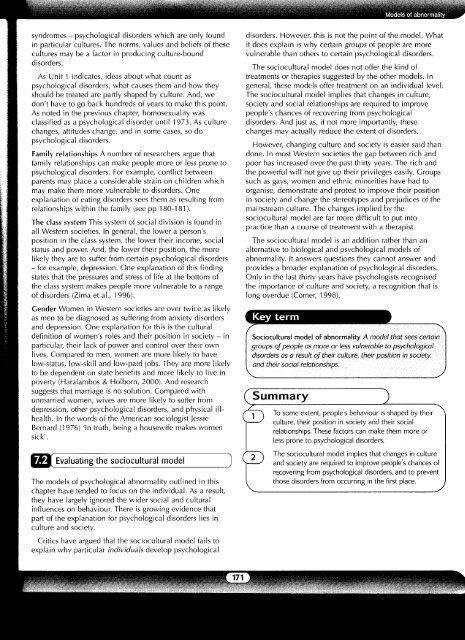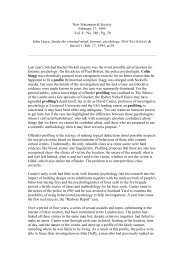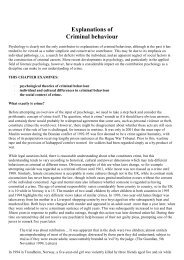Ch 11 - Jeff Standen
Ch 11 - Jeff Standen
Ch 11 - Jeff Standen
You also want an ePaper? Increase the reach of your titles
YUMPU automatically turns print PDFs into web optimized ePapers that Google loves.
syndromes - psychological disorders which are only found<br />
in particular cultures. The norms, values and beliefs of these<br />
cultures may be a factor in producing culture-bound<br />
disorders.<br />
As Unit 1 indicates, ideas about what count as<br />
psychological disorders, what causes them and how they<br />
should be treated are partly shaped by culture. And, we<br />
don't have to go back hundreds of years to make this point.<br />
As noted in the previous chapter, homosexuality was<br />
classified as a psychological disorder until 1973. As culture<br />
changes, attitudes change, and in some cases, so do<br />
psychological disorders.<br />
Family relationships A number of researchers argue that<br />
family relationships can make people more or less prone to<br />
psychological disorders. For example, conflict between<br />
parents may place a considerable strain on children which<br />
may make them more vulnerable to disorders. One<br />
explanation of eating disorders sees them as resulting from<br />
relationships within the family (see pp 180-181).<br />
The class system This system of social division is found in<br />
all Western societies. In general, the lower a person's<br />
position in the class system, the lower their income, social<br />
status and power. And, the lower their position, the more<br />
likely they are to suffer from certain psychological disorders<br />
- for example, depression. One explanation of this finding<br />
states that the pressures and stress of life at the bottom of<br />
the class system makes people more vulnerable to a range<br />
of disorders (Zima et al., 1996).<br />
Gender Women in Western societies are over twice as likely<br />
as men to be diagnosed as suffering from anxiety disorders<br />
and depression. One explanation for this is the cultural<br />
definition of women's roles and their position in society - in<br />
particular, their lack of power and control over their own<br />
lives. Compared to men, women are more likely to have<br />
low-status, low-skill and low-paid jobs. They are more likely<br />
to be dependent on state benefits and more likely to live in<br />
poverty (Haralambos & Holborn, 2000). And research<br />
suggests that marriage is no solution. Compared with<br />
unmarried women, wives are more likely to suffer from<br />
depression, other psychological disorders, and physical illhealth.<br />
In the words of the American sociologist Jessie<br />
Bernard (1976) 'In truth, being a housewife makes women<br />
sick'.<br />
Evaluating the sociocultural model<br />
The models of psychological abnormality outlined in this<br />
chapter have tended to focus on the individual. As a result,<br />
they have largely ignored the wider social and cultural<br />
influences on behaviour. There is growing evidence that<br />
part of the explanation for psychological disorders lies in<br />
culture and society.<br />
disorders. However, this is not the point of the model. What<br />
it does explain is why certain groups of people are more<br />
vulnerable than others to certain psychological disorders.<br />
The sociocultural model does not offer the kind of<br />
treatments or therapies suggested by the other models. In<br />
general, these models offer treatment on an individual level.<br />
The sociocultural model implies that changes in culture,<br />
society and social relationships are required to improve<br />
people's chances of recovering from psychological<br />
disorders. And just as, if not more importantly, these<br />
changes may actually reduce the extent of disorders.<br />
However, changing culture and society is easier said than<br />
done. In most Western societies the gap between rich and<br />
poor has increased over the past thirty years. The rich and<br />
the powerful will not give up their privileges easily. Groups<br />
such as gays, women and ethnic minorities have had to<br />
organise, demonstrate and protest to improve their position<br />
in society and change the stereotypes and prejudices of the<br />
mainstream culture. The changes implied by the<br />
sociocultural model are far more difficult to put into<br />
practice than a course of treatment with a therapist.<br />
The sociocultural model is an addition rather than an<br />
alternative to biological and psychological models of<br />
abnormality. It answers questions they cannot answer and<br />
provides a broader explanation of psychological disorders.<br />
Only in the last thirty years have psychologists recognised<br />
the importance of culture and society, a recognition that is<br />
long overdue (Comer, 1998).<br />
Key term<br />
Sociocultural model of abnormality A model that sees certain<br />
groups of people as more or less vulnerable to psychological<br />
disorders as a result of their culture, their position in society,<br />
and their social relationships.<br />
( Summary<br />
2<br />
N To some extent, people's behaviour is shaped by their<br />
>—-— culture, their position in society and their social<br />
relationships. These factors can make them more or<br />
less prone to psychological disorders.<br />
The sociocultural model implies that changes in culture<br />
and society are required to improve people's chances of<br />
recovering from psychological disorders, and to prevent<br />
those disorders from occurring in the first place. ,<br />
Critics have argued that the sociocultural model fails to<br />
explain why particular individuals<br />
develop psychological







